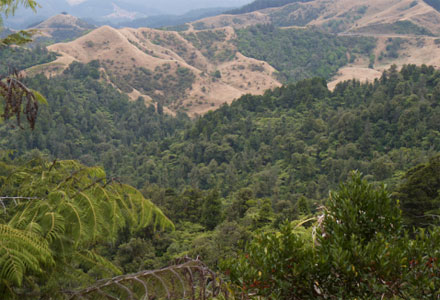
Improving a farm environment by planting a forestry block gives farmers as much satisfaction as lifting the values of their land. But it also required careful planning if landowners are to reap its benefits. Source: Stuff NZ
That would dictate how the trees are managed, New Zealand Farm Forestry Association Waikato secretary John Simmons told farmers at a Beef+Lamb farm forestry field day in Te Awamutu.
Farmers planted trees for many reasons, ranging from nutrient offsetting, timber, erosion protection, livestock shade, aesthetics, carbon and soil protection.
They should consider how the planted area would look like in 20 years time, he said.
Simmons said farmers should also undertake a plan before planting so they would know the economic case of harvesting.
This is especially important in steep, marginal hill country where it is costly for harvesters to get on sites and access trees.
John Hayward and Susan O’Regan have planted about 30,000 native trees on their dairy farm over the past eight years including 15 hectares of manuka and 5 hectares of pine trees. There had to be value in the product to make it worthwhile if the forestry block was for growing logs for the export market.
“It’s like not finishing your lambs right or not getting the weight gains on your cattle when you decide to put them on the truck.
“Undergoing good site preparation before planting a tree was so vital. It influences that tree’s wellbeing so much from the get-go.”
Once in the ground, timely silviculture was required as was using skilled operators.
“I can’t emphasise that enough,” Simmons said. “There’s a right way to do it and a wrong way to do it and the wrong way will end up costing you money.”
Waikato was a great environment to grow trees. The region did not get catastrophic storms or droughts that affected hundreds of thousands of hectares of hill country.
The site index, which is used by farm foresters as a measurement tool for the quality of tree stands, rates Waikato as some of the best country for radiata, he said.
Simmons highlighted the potential value of forestry using a 2013 case study where an Otorohanga farmer had a three hectare block of 23-year-old radiata at 200 stems per hectare.
“He returned off that $37,000 per hectare, which equate to $1645 per year.”
Under current prices, that return would be even higher.
Host farmers John Hayward and Susan O’Regan spent eight years, planting riparian areas and protecting wetlands, planting about 30,000 native trees and retiring steeper, erosion-prone hill country on their dairy farm.
They have also entered into a partnership with Comvita that will see the company plant manuka on the retired erosion-prone land.
About 15ha of manuka has been planted and 5ha of pine. When completed, Hayward estimates there will be 23ha of forestry planted and about 10% of his land will be in trees
“If every property had an objective of 10% as some sort of offset, that would add a huge amount to the catchment in benefits,” he said.
He also got a lot of enjoyment out of seeing the bush.
“That’s a big thing for me.”
The manuka will mitigate erosion and reduce the overall nitrogen leaching factor on the property and the pair will receive a share in the resulting honey production for 20-25 years.
A wetland covers 3ha and there is a 4ha stock-proofed area of native bush that includes a waterfall.
Hayward said he would not get rich from manuka, but it would mitigate sediment, stop erosion and protect biodiversity.
“It will add to what I’m trying to create here. I visualise this place as a kind of a garden, and I’ve sat here and planned what I want.”





